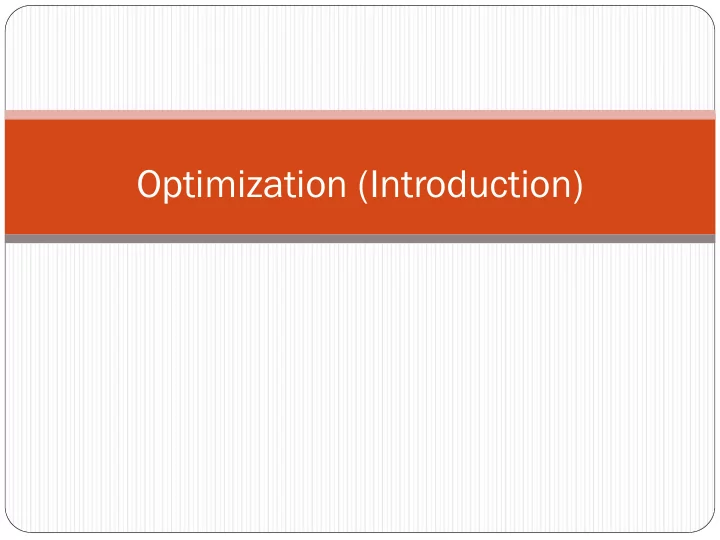

Optimization (Introduction)
Optimization Goal: Find the minimizer 𝒚 ∗ that minimizes the objective (cost) function 𝑔 𝒚 : ℛ " → ℛ Unconstrained Optimization
Optimization Goal: Find the minimizer 𝒚 ∗ that minimizes the objective (cost) function 𝑔 𝒚 : ℛ " → ℛ Constrained Optimization
Unconstrained Optimization • What if we are looking for a maximizer 𝒚 ∗ ? 𝑔 𝒚 ∗ = max 𝑔 𝒚 𝒚
Calculus problem: maximize the rectangle area subject to perimeter constraint max 𝒆 ∈ ℛ !
𝐵𝑠𝑓𝑏 = 𝑒 $ 𝑒 % 𝑒 % 𝑒 $ 𝑄𝑓𝑠𝑗𝑛𝑓𝑢𝑓𝑠 = 2(𝑒 $ + 𝑒 % ) 𝑒 % 𝑒 $
Unconstrained Optimization 1D
What is the optimal solution? (1D) 𝑔 𝑦 ∗ = min 𝑔 𝑦 " (First-order) Necessary condition (Second-order) Sufficient condition
Types of optimization problems 𝑔 𝑦 ∗ = min 𝑔: nonlinear, continuous 𝑔 𝑦 and smooth " Gradient-free methods Evaluate 𝑔 𝑦 Gradient (first-derivative) methods Evaluate 𝑔 𝑦 , 𝑔′ 𝑦 Second-derivative methods Evaluate 𝑔 𝑦 , 𝑔′ 𝑦 , 𝑔′′ 𝑦
Does the solution exists? Local or global solution?
Example (1D) Consider the function 𝑔 𝒚 = 7 ! 8 − 7 " 9 − 11 𝑦 : + 40𝑦 . Find the stationary point and check the sufficient condition 100 - 6 - 4 - 2 2 4 6 - 100 - 200
Optimization in 1D: Golden Section Search • Similar idea of bisection method for root finding • Needs to bracket the minimum inside an interval • Required the function to be unimodal A function 𝑔: ℛ → ℛ is unimodal on an interval [𝑏, 𝑐] ü There is a unique 𝒚 ∗ ∈ [𝑏, 𝑐] such that 𝑔(𝒚 ∗ ) is the minimum in [𝑏, 𝑐] ü For any 𝑦 ; , 𝑦 : ∈ [𝑏, 𝑐] with 𝑦 ; < 𝑦 : 𝑦 : < 𝒚 ∗ ⟹ 𝑔(𝑦 ; ) > 𝑔(𝑦 : ) § 𝑦 ; > 𝒚 ∗ ⟹ 𝑔(𝑦 ; ) < 𝑔(𝑦 : ) §
𝑔 𝑔 $ $ 𝑔 𝑔 & & 𝑔 ' 𝑔 𝑔 % % 𝑔 ' 𝑦 $ 𝑦 $ 𝑦 & 𝑦 & 𝑦 % 𝑦 ' 𝑦 % 𝑦 ' 𝑑 𝑑 𝑏 𝑏 𝑐 𝑐
Golden Section Search
Golden Section Search What happens with the length of the interval after one iteration? ℎ ! = 𝜐 ℎ " Or in general: ℎ #$! = 𝜐 ℎ # Hence the interval gets reduced by 𝝊 (for bisection method to solve nonlinear equations, 𝜐 =0.5) For recursion: 𝜐 ℎ ! = (1 − 𝜐) ℎ " 𝜐 𝜐 ℎ " = (1 − 𝜐) ℎ " 𝜐 % = (1 − 𝜐) 𝝊 = 𝟏. 𝟕𝟐𝟗
Golden Section Search • Derivative free method! • Slow convergence: |𝑓 ?B; | lim = 0.618 𝑠 = 1 (𝑚𝑗𝑜𝑓𝑏𝑠 𝑑𝑝𝑜𝑤𝑓𝑠𝑓𝑜𝑑𝑓) 𝑓 ? ?→A • Only one function evaluation per iteration
Example
Newton’s Method Using Taylor Expansion, we can approximate the function 𝑔 with a quadratic function about 𝑦 C 𝑔 𝑦 ≈ 𝑔 𝑦 C + 𝑔 D 𝑦 C (𝑦 − 𝑦 C ) + ; : 𝑔 D ′ 𝑦 C (𝑦 − 𝑦 C ) : And we want to find the minimum of the quadratic function using the first-order necessary condition
Newton’s Method • Algorithm: 𝑦 0 = starting guess 𝑦 123 = 𝑦 1 − 𝑔′ 𝑦 1 /𝑔′′ 𝑦 1 • Convergence: • Typical quadratic convergence • Local convergence (start guess close to solution) • May fail to converge, or converge to a maximum or point of inflection
Newton’s Method (Graphical Representation)
Example Consider the function 𝑔 𝑦 = 4 𝑦 9 + 2 𝑦 : + 5 𝑦 + 40 If we use the initial guess 𝑦 C = 2 , what would be the value of 𝑦 after one iteration of the Newton’s method?
Recommend
More recommend